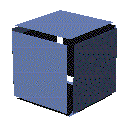TAPESTRY: The Art of Representation and Abstraction
Data Types: B-REP or SURFACE

What's it all about?
The reason the world is not "see through" (wire frame) is that there are opaque surfaces which get in the way and block the view. In fact, the way we see most objects is through the light reflecting from their surfaces. Thus, the critical part of the object to capture is the surface itself, not the edges or the interior. When you've represented the "bounding surface" of the object, you've created a "boundary representation", or b-rep model of the object.This is quite similar to the cardboard models built by architects. The focus is on the way the model appears to the viewer.
Primitives
The basic primitive of a b-rep model is the polygon. The simplest polygon, and the only one that can be guaranteed to be planar, is a triangle, so some programs form all objects out of triangles. Most have a limit on how complex any specific polygon.Attributes
Color, transparency, glossiness, smoothing, etc. There is a close correlation between the available rendering algorithms and the surface attributes of the objects.Relationships
There are quite a few fairly complex assembleges of polygons. Many times these are called "meshes" because they use a special data structure to minimize the amount of redundancy which usually occurs in a 3D model where two lines/faces share a common vertex.Examples
Google SketchUp; AutoCAD: 3DFACE, thickened lines, etc.; Rhino surfaces; form•Z surfaces; Maya; Super-3D.Last updated: April, 2014
